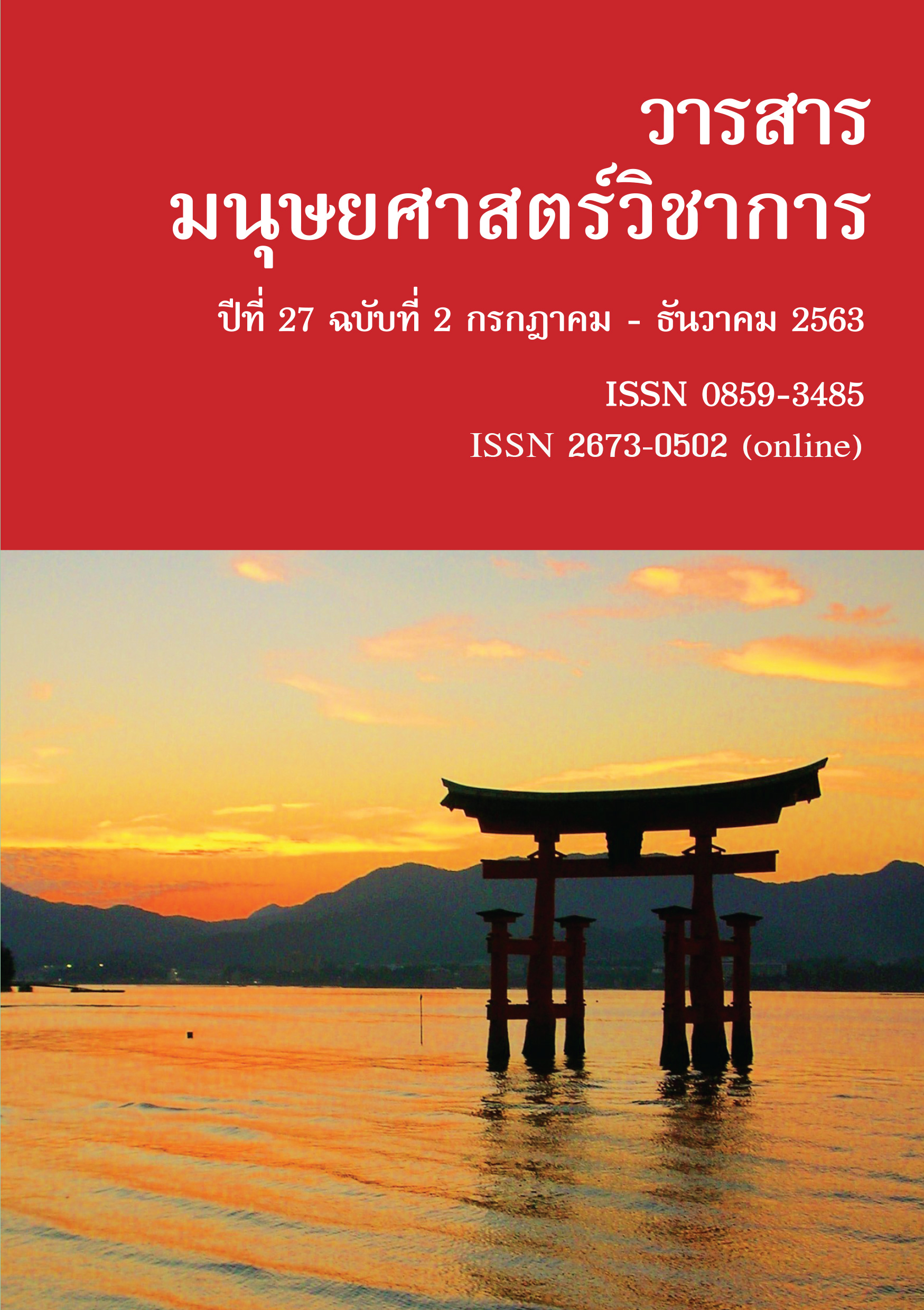Chinese Cultural Diplomacy towards ASEAN Countries Case Study of Confucius Institutes in Thailand
Main Article Content
Abstract
Having successfully developed itself under the concept of “Chinese Socialism.” China has stepped forward to become a global superpowers in politics and economics. Also, China is eager to strengthen its power in the cultural sphere through cultural diplomacy. This can be seen from President XI Jinping’s strong will to promote China’s cultural soft power by disseminating modern Chinese values and showing the charm of Chinese culture to the world. As such, China’s cultural diplomacy has become stronger in many countries in recent years since Chinese leaders realize the significant role of culture as a strategic means to expand its influence in the global community. This cultural diplomacy strategy has been implemented since the 1990s and has shaped China’s foreign policy towards Southeast Asian countries including Thailand. This paper aims to discuss how China uses this cultural diplomacy strategy towards Thailand, Thailand’s responses to the diplomacy, and the changing roles of Chinese communities in Thai society. Also, it will explore the contribution of Confucius Institutes as part of the strategy to propagate images of China, as well as the impacts and limitations of Confucius Institutes. Finally, this paper will examine the role of Confucius Institutes in the newly established “One Belt One Road” strategies, which are expected to have a strong impact on ASEAN countries including Thailand.
Article Details
References
Academy for Cultural Diplomacy. (2015). Chinese Diaspora Across the World: A General Overview. Retrieved April 15, 2020, from http://www. culturaldiplomacy.org/academy/index.php?chinese-diaspora.
Auethavornpipat, R. (2014, April). Revealing China’s Hegemonic Project in Thailand: How the Confucius Institute Furthers the Chinese State’s International Ambitions. Paper presented at the 12th International Conference on Thai Studies, University of Sydney. Retrieved November 29, 2015, from http://sydney.edu.au/southeast-asia-centre/documents/ pdf/auethavornpipat-ruji.pdf.
Chiangmai University. (2012). The Chinese volunteer teacher. Retrieved October 24, 2015, from http://archive.lib.cmu.ac.th/full/T/2555/regio40755sb_ ch1.pdf.
Chinese Studies Center. (2008). Karnrienkarn son pasajeannaiprathesthai [Chinese Language Teaching in Thailand], Bangkok: Chinese Studies Center.
Confucius Institute at Assumption University. (2015). Opening ceremony schedule of Confucius constitution at Assumption university. Retrieved April 6, 2020, from http://www.ci.au.edu/th/index.php/2015-08-28-09- 21-14/31-2015-08-28-09-16-16.
Ding, Sheng. (2008). To Build A “harmonious World”: China’s Soft Power Weilding in the Global South. Journal of Chinese Political Science 13(2), 193-213.
Fernquest, J. (2016). New wave of Chinese coming to live in Thailand. Retrived April 2, 2020, from https://www.bangkokpost.com/learning/advanced/ 1093148/new-wave-of-chinese-coming-to-live-in-thailand.
Guo, Xiaolin. (2008, January). Repackaging Confucius PRC Public Diplomacy and the Rise of Soft Power. Institute for Security & Development Policy, 33-34. Retrieved November 29, 2015, from http://www.isdp.eu/images/ stories/isdp-main-pdf/2008_guo_repackaging-confucius.pdf.
Hanban. (2015). The first “Confucius Institute of Maritime Silk Road” established in Thailand. Retrieved April 8, 2020, from http://english.hanban.org/ article/2015-07/06/content_608534.htm.
Hanban. (n.d.) About Confucius Institute. Retrieved April 8, 2020, from http:// english.Hanban.org/node_10971.htm.
Hanban. (n.d.) Retrieved April 8, 2020, from http://www.hanban.edu.cn/ article/2015-05/22/content596317.htm.
Joseph S. Nye and Wang Jisi. (2009). The Rise of China’s Soft Power and its Implications for the United States. The Rise of China’s Soft Power.
Kasetsart University. (2013) The Chinese volunteer teacher. Retrieved October 24, 2015, from http://www.intaff.ku.ac.th/Admin/WBfund/data/pdffiles/mua/mua56_10.pdf.
Kurlantzick, J. (2006, September). China’s Charm Offensive in Southeast Asia. Current History, 270-276.
Lucio Blanco Pitlo III. (2015). ASEAN Connectivity and China’s ‘One Belt, One Road’. The Diplomat. Retrieved April 24, 2020, from http://thediplomat. com/2015/03/asean-connectivity-and-chinas-one-belt-one-road/.
Painter, H. (2014). Doubts about the integrity of Confucius Institutes lead to mounting criticism. The John William Pope Center for Higher Education Policy. Retrieved April 19, 2020, from http://www.popecenter.org/com mentaries/article.html?id=3115.
Patcharee, M. (2013). A Comparative Study of Attitudes towards China of Non-Students and Students in the Confucius Institutes in Thailand . Retrieved October 24, 2015, from http://grad.rsu.ac.th/Upload/Conference/ %E0%B8%9A%E0%B8%97%E0%B8%84%E0%B8%A7%E0%B8%B2 %E0%B8%A1_%E0%B8%9E%E0%B8%B1%E0%B8%8A%E0%B8% A3%E0%B8%B5.pdf.
Sahlins, M. (2014). Confucius Institutes: Academic Malware. The Asia-Pacific Journal, 12(46). Retrieved January 4, 2 016, from https://apjjf. org/2014/12/46/Marshall-Sahlins/4220.html.
Supaporn. (2015) .17 นายกรัฐมนตรีไทยเชื้อสายจีน. Retrived April 2, 2020, from http://www.lib.hcu.ac.th/KM/17-thai-prime-ministers/.
Thailand Business Information Center in China. (2012). SethapanKrajangwongs, “MueaBajangmeeroskaoniaoturianmuea show pienlianpienna pen hanuman เมื่อบ๊ะจ่างมีรสข้าวเหนียวทุเรียนเมื่อโชว์เปี้ยนเหลี่ยนเปลี่ยนเป็น หน้าหนุมาน. Retrieved April 10, 2020, from http://www.thaibizchina. com/thaibizchina/th/articles/detail.php?IBLOCK_ID=70&SECTION_ ID=533&ELEMENT_ID=10747.
Thairath Online. (2015). Khon jean thalakthiawthaikrungthepsud hit danthongtiaw tirmasraek to. Thairath. Retrieved April 19, 2020, from http://www. thairath.co.th/content/487445.
U.S. Government. (2011, February). Another U.S. Deficit-China and America- Public Diplomacy in the Age of the Internet. Committee on Foreign Relations report. Retrieved April 7, 2020, from http://www.foreign. senate.gov/imo/media/doc/S%20Prt%20Another%20US%20Deficit%20 China%20and%20America%20Public%20Diplomacy%20in%20the%20 Age%20of%20the%20Internet%2003042011.pdf.
VOAnews Online. (2013). Retrieved January 4, 2016, from http://www.voanews. com/content/chinese-confucious-institute-project-raises-concern-in-vietnam/1780894.html.
Volodzko, D. (2015). China’s Confucius Institutes and the Soft War. The Diplomat. Retrieved April 19, 2020, from http://thediplomat.com/2015/07/ chinas-confucius-institutes-and-the-soft-war.
Wade, Geoff. (2014). Retrieved December 20, 2015, “Confucius Institutes and Chinese soft power in Australia,” The Parliament of Australia, http:// www.aph.gov.au/About_Parliament/Parliamentary_Departments/ Parliamentary_Library/FlagPost/2014/November/Confucius_Institutes_ and_Chinese_soft_power_in_Australia.
Womack, B. (2005). Dancing Alone: A Hard Look at Soft Power. The Asia- Pacific Journal, 3(11). Retrieved April 24, 2020, from http://www. japanfocus.org/-Brantly-Womack/1975.
Xuetong, Yan. (2011). How China Can Defeat America. The New York Times. Retrieved April 14, 2020, from http://www.nytimes.com/2011/11/21/ opinion/how-china-can-defeat-america.html?_r=1.


